Problem of “Cold Tumor”
In late years it became clear that the immune system, particularly T cell immunity, can be the powerful weapon for the fight to cancer. T cell-based immunotherapies such as immune checkpoint inhibitors and gene-engineered T cell therapies have been approved. Thus, the era of the practical application of cancer immunotherapy began; however the existing immunotherapies are still only effective for the limited population of patients.
Recent preclinical and clinical research on resistant cancers have revealed that there are two types of cancers: immunologically “hot tumor” and “cold tumor”. Although the existing treatments are effective for hot tumor, it has become clear that they are difficult for cold tumor to work. Hot tumor (or inflamed tumor) is already in immunologically active state where the body’s immune system finds cancer and is fighting against it even before starting treatment. In this type of cancer, immunotherapy is usually effective. Cold tumor (or non-inflamed tumor) is further divided to two classes: immune excluded cold tumor and immune ignored (or desert) cold tumor. In immune excluded cold tumor, the immune system recognizes but cannot affect tumor by various reasons. In immune ignored cold tumor, the immune system has not found tumor at all. In cold tumor, even if the function of anti-tumor immunity is enhanced by immunotherapies, it will not lead to therapeutic effect.

